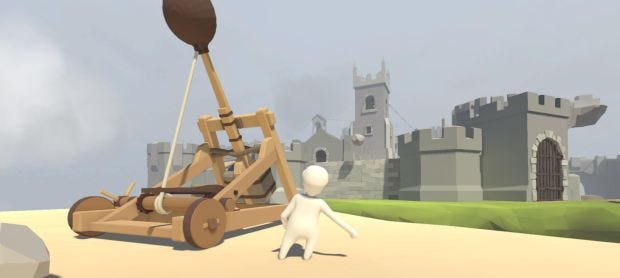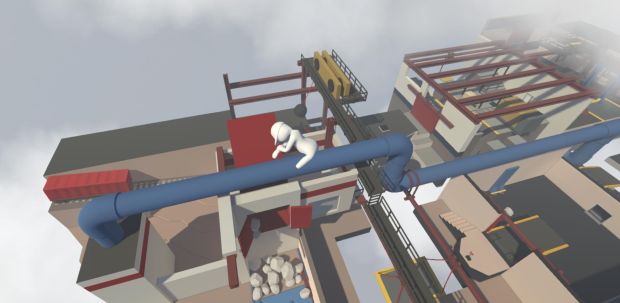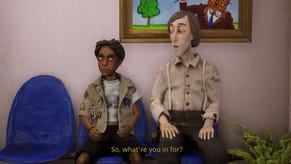Wot I Think - Human: Fall Flat
Grow Beasts
It's hard not to compare Human: Fall Flat with Ubisoft's Grow Home and Boneloaf's Gang Beasts, because Human: Fall Flat [official site] tumbles in the exact same physics-powered footsteps. In Grow Home you control a little robot called BUD, unsteady on his feet, using physics to solve puzzles and climb a giant plant. In Gang Beasts you control little blobby creatures, unsteady on their feet, using physics to have multiplayer fights. In Human: Fall Flat you control a little blobby creature called Bob, unsteady on his feet, using physics to solve puzzles and progress through its rooms. However, rather importantly, HFF makes a strong effort to do something appropriately different with the same ideas. Here's wot I think.
First of all, Bob can't climb! Well, he can, a bit, but his independently controlled arms (see, I'm not kidding), are only capable of hauling himself up over low ledges. Despite his appearing to have similarly suckery-hands to BUD, he cannot use them to scale vertical surfaces - instead you need to aim his hand-blobs on top of a surface and hoik yourself up, which is itself very satisfying. His antics at ground level, meanwhile, are much more involved, challenged with a series of floating levels to find his (I only say "his" because I read his name was Bob - he seems entirely without gender) way through puzzle-filled locations.
And I thought I wasn't going to like it. For the first couple of levels, it felt derivative but less than its peers, both clumsy and underpowered. I know, from checking old brain scans, that I felt very differently when I started Grow Home - there I immediately felt delight, and overwhelmingly paternal toward that little red bot. I immediately emotionally connected with him. With Bob, the game presented a pharmaceutical sterility to the featureless humanoid and his environs. Blank-faced, blank-everythinged, this unfinished Pillsbury Doughboy left me unenamoured. I think, right up until I got the hang of climbing.
His animations at first seemed simply clumsy, missing that appealing vulnerability. Incapable rather than inchoate. And then, when realising that to safely jump a gap I need to raise the little guys hands above his head (hold down both mouse buttons, look up a bit) and then run toward the edge, it was all in place. He looks adorably daft. Leap, click both mouse buttons to grab at the other ledge, and then look downward to start hauling up. Remember to unclick to not look ridiculously ungainly, and now I'm on Bob's side.
After this point, I really feel your mileage may vary. With BUD, you had a goal, goddammit, of reaching the top of that blasted tree. With Bob, you've no real idea where you're going, other than that each increasingly sprawling level ends with your falling through the sky to the next one. For BUD it felt desperate, urgent. For Bob it feels trivial, if entertaining. And then that last part really does depend upon how patient you're feeling at any moment.
After knocking a box off a high platform where I needed it (I was smashing some windows with it, sue me), I had the most extraordinarily laborious process to get it back up there, rather than restart the large level. I was building steps out of crumbled rock wall, but knocking them down as fast thanks to Bob's outlandishly cumbersome limbs. The former felt satisfying, as though I were beating the game in a way it hadn't planned; the latter felt morose, tiresome, as my efforts were thwarted by some hard-coded frustration. I did it in the end, and yes, it felt like I'd discovered the cure for cancer while reaching the peak of Everest, but I'm still not sure it was entirely worth the swearing.
However, that ability to improvise around the theme is very rewarding. A puzzle wanted me to knock down a wall by swinging rubble at it with my arms. I know that because I spent so long faffing around building a bridge that went around the side of the wall out of planks and rocks as counter-weights that it thought I was stuck and dropped a hint. No no, game, just having fun over here. The point being, you can - there are multiple ways to solve a bunch of the puzzles, and some of them certainly never considered by the creators. It's just limited by how much of the roly-poly physics you're capable of enduring at any time.
My fondness for it swings back and forth accordingly. The levels look lovely after you get through the first couple, far more colour and character. The castle is especially splendid. Then I get annoyed by the clumsiness for a bit and think about how much more fun I'd be having in a physics puzzle game if I were able to walk in a straight line. Then I feel a massive sense of achievement for knocking a wall over in a way that would have been boringly easy if I could walk in a straight line.
Human: Fall Flat is unquestionably charming, and tremendous fun when it's not annoying me so much I want to find the developers and put staples in their toes. It's a logical next step for the Grow Home concept, and they beat Ubisoft to releasing it before Grow Home 2, so kudos for that. They've done enough with the idea to make it their own, no matter how naggingly familiar it all feels. And that climbing up animation is just the loveliest.
Human: Fall Flat is out now on Windows, Mac and Linux via Steam and Humble for £12/$15/€15.













